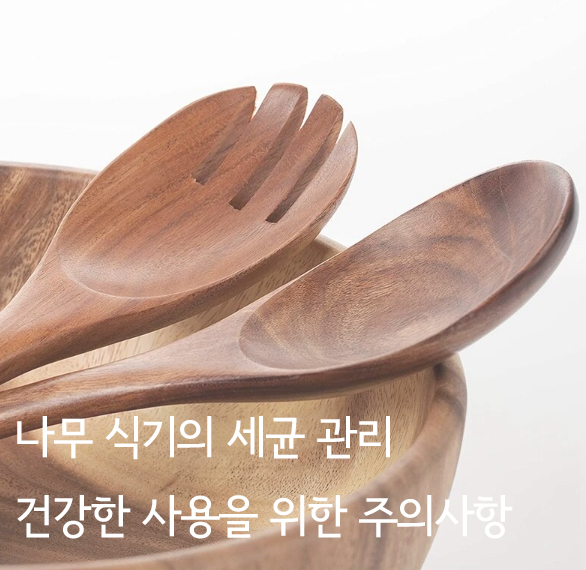
나무 식기의 세균 취약성
Vulnerability of Wooden Utensils to Bacterial Growth
요거트를 먹거나 시리얼을 먹을 때 나무 숟가락을 사용하는 경우가 많습니다. 하지만 나무 식기를 세척할 때 주의해야 할 점들이 있습니다. 나무 식기는 가볍고 환경에도 친화적이지만, 제대로 관리하지 않으면 식중독균 등의 세균이 번식할 수 있습니다.
나무 식기는 세균 번식에 취약합니다. 나무 소재의 특성상 미세한 틈이 존재하여 음식물 찌꺼기가 쉽게 쌓일 수 있습니다. 나무 도마 등을 세척할 때 틈 사이에 음식물이 남지 않도록 주의해야 합니다. 이렇게 하지 않으면 오염된 식품이 닿을 때 교차 오염 가능성이 높아집니다. 미국 식품의약국(FDA)의 연구에 따르면, 캄필로박터균과 대장균과 같은 식중독 원인균은 나무 도마 표면의 구멍에 적게는 2시간부터 길게는 며칠까지 생존할 수 있다는 결과가 있습니다.
Many people often use wooden utensils, such as spoons, when eating yogurt or cereal. However, there are some precautions to be mindful of when cleaning wooden utensils. While wooden utensils are lightweight and eco-friendly, improper maintenance can lead to the breeding of bacteria, including those causing foodborne illnesses.
Wooden utensils are vulnerable to bacterial growth. Due to the nature of wood, small crevices can easily trap food residue. Care should be taken when cleaning wooden cutting boards or utensils to ensure no food particles remain stuck in these crevices. Otherwise, there is an increased risk of cross-contamination when contaminated food comes in contact with these surfaces. According to research by the U.S. Food and Drug Administration (FDA), foodborne pathogens like Campylobacter and E. coli can survive on wooden surfaces for as little as 2 hours and up to several days.
올바른 나무 식기 세척 방법
Proper Cleaning Methods for Wooden Utensils
나무 식기를 세척할 때는 주방 세제보다는 미지근한 물을 사용해야 합니다. 세제가 틈 사이에 남을 수 있기 때문입니다. 베이킹소다 한 숟가락을 물에 풀고, 부드러운 스펀지로 나무 식기를 살살 닦아내면 좋습니다. 베이킹소다가 없다면 쌀뜨물과 식초를 9대 1로 섞은 물을 사용할 수도 있습니다. 이후 식초를 넣은 물로 나무 식기를 씻어내고, 깨끗한 물로 여러 번 헹궈내면 됩니다. 뜨거운 물을 사용하는 것은 피해야 합니다. 뜨거운 물은 나무의 틈을 벌릴 수 있어 음식물이 더 쉽게 스며들 수 있습니다. 세척 후 나무 식기를 제대로 건조하는 것도 중요합니다. 건조하지 않은 식기에는 곰팡이가 번식할 수 있으므로 마른 천으로 물기를 닦아내고, 서늘하고 그늘진 곳에서 건조시켜야 합니다.
When washing wooden utensils, it’s better to use lukewarm water instead of kitchen detergent to prevent soap residue from lingering in the crevices. Soaking wooden utensils in a mixture of one tablespoon of baking soda and water and gently scrubbing them with a soft sponge is recommended. If baking soda is not available, a solution of 9 parts water to 1 part vinegar can be used. Afterward, rinse the wooden utensils with the vinegar solution and then thoroughly with clean water. Avoid using hot water as it can widen the wood’s pores, making it easier for food particles to penetrate. Properly drying wooden utensils after cleaning is equally important. Failure to dry them thoroughly can lead to mold growth. Use a dry cloth to remove excess moisture and allow the utensils to air-dry in a cool, shaded area.
세균 번식을 막기 위해 나무 식기를 올바르게 관리하는 것이 중요합니다. 식품 안전을 위해 세심한 주의가 필요합니다. 함께 실천해보시고 안전한 식기로 맛있는 식사를 즐기시길 바랍니다.
Properly managing wooden utensils to prevent bacterial growth is crucial for food safety. Diligent attention is necessary for food safety. We hope these practices contribute to enjoying a safe and delightful dining experience.
